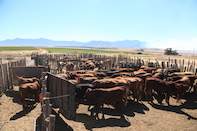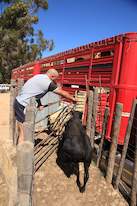
Besides making use of an animal’s point of balance and flight zone, low stress livestock handling takes prey animal’s natural instincts and fears into account.
Sheep, cattle and pigs first of all like their routines, so any disruptions to their normal routine will likely cause distress. Dairy cattle, for example, form a natural hierarchy governing the order in which they will enter a dairy.
Disturbing this hierarchy will upset the cows and negatively impact milk production. In the same way, variance from an old route or having a new stockman can cause stress.
The Herd Instinct
Sheep, cattle and pigs are also highly social animals. So, separating individual animals from the herd or flock, even for a brief moment, will cause distress.
Livestock tend to keep eye contact with one another because of this herd instinct, enabling them to stay together when they are moved. The dominant animals usually move at the core of the herd, while the weaker will remain on the outer edges.
Stockmen can use this knowledge to their advantage, by moving the herd as a whole and not separating individual animals from one another. This is especially important when working with bulls, which might be territorial and become aggressive when they are treated individually, and cows with calves, who might also become aggressive because of their maternal instincts.
The trick is to get the herd to bundle together and to then to identify a leading animal through which the movement of the herd as a whole can be directed.
Fear Stimulus
Dr Temple Grandin, an animal behaviour expert, identifies fear as one of the main emotions driving the behaviour of prey animals, such as sheep, cattle and horses. Since prey animals startle easily, handlers have to move at a normal walking pace with steady and deliberate movements, almost like a stalking animal would do.
There should also not be any noises such as whistling, yelling or a whip cracking or sudden jerky movements or waving of arms that could induce fear. Low stress livestock handling, only works on animals that are slightly anxious, according to Grandin, because animals that are overly anxious will start to run and upset the herd as a whole.
Problem Animals

Farmers may at times have animals that appear aggressive for no apparent reason. This may be due to their genetics, temperament or past experiences. Dr Grandin explains that a horse, for example, that falls the first time it is loaded in a trailer may start to fear all trailers from then on.
If, however, the horse had been loaded in trailers many times before, without having any negative experiences and then has a fall after the twenty-fifth time, the horse could end up only fearing that specific trailer or the person that might have loaded it into the trailer. If the person had a beard, the horse may end up associating bearded men with the event and start fearing bearded men in general.
So when a farmer encounters a “problem” animal it is important to try and analyse why the animal is behaving in that specific way and to find a way to overcome the fear stimulus. The fear stimulus can then either be removed or replaced with something else.
Animals with overly anxious or aggressive temperaments will be very difficult to manage, so it might make sense to eliminate these from the herd if remedial actions do not work. Working with breeds that are known for their ease of handling and affable temperaments will also ease herd management.